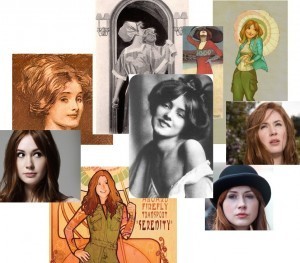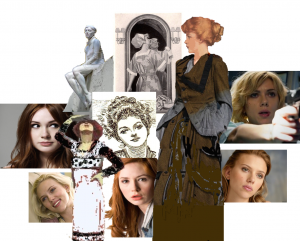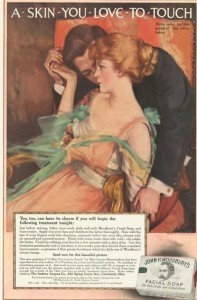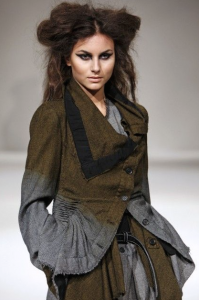Building a Protagonist Visually
Welcome to Discovery Month on Argh. It’s what I’m obsessing on right now, so you’re stuck with it.
If there’s one thing that’s a given about writing fiction, at least the way I write it, is that you find out most of what you need to know by writing the story. But when you’re collaborating on fantasy set in a world that you’re making up as you go, you do a lot of discovery with other people first. In this case, “other people” is mostly Toni, although Krissie will be back next week. So Toni and I do a lot of talking in e-mail, mostly floating ideas, comparing notes, and figuring out problems; the one thing we can’t do together is design our protagonists. But the one thing we have to do is introduce our protagonists to each other since they’re going to be in each other’s stories. So for the first time in a long time, I’m having to consciously do discovery on my protagonist before I write her, which makes it a lot easier to see how she develops. Of course, once I start to actually write her, all bets are off, but I really think I’ve probably got 50% of her, which is amazing at this stage. I won’t have 100% until the rewrites are finished, so 50% is a LOT.
At the very beginning, we did very basic descriptions, answering the question, “Who do you want to write about?” Krissie said, “A cross-dressing stable girl.” I think Toni said, “An assassin with heightened magical powers.” (Toni?) I said, “A cat burglar who works as a waitress and lives in a church belltower.” In all honesty, I have no idea why I wanted those things. I just did. But I know why I said the next part: “She has no magical powers and doesn’t want any.” That was in part to differentiate her from Keely, Toni’s character, but also, combined with the cat burglar and pickpocket stuff, it made Cat someone who was invested in stability, in concrete things like walls and roofs, somebody who felt the grooves in the stone as she climbed. I wanted Cat to be all physical skill and experience, no magic.
So I put together a composite of her church belltower (because where somebody lives is really important to me) and added a dragon gargoyle because I liked it and planned to make the gargoyle come alive later, although that may be gone now. Cat fed a one-eyed raven up in the belltower, but that was as close as she got to a pet. She worked at Maggie’s Ear as a waitress, and then she became Maggie’s dependable right-hand woman. So home, animals, work, friends, the basics. I wrote pages of description for her for our e-mail loop, then changed that and wrote pages more. I gave her a back story that will never see the light of day; I just needed to know it to write her in the now. And I made composite portraits of her over and over and over.
If you’re collaborating, you need to have pictures that you can show the other people and say, “This is what my girl looks like.” The problem with that is that the picture is probably of an actress in a specific role and it becomes too limiting. That’s why I like going through Google and pulling a dozen or so pictures that capture the spirit of the character, rather than just one that nails her to the board like a butterfly with a pin through her. If there’s not just one face, you don’t get fixated on that character/actress/personality. You have to look at all of the pictures to get the totality of the personality. Then you write the story and it all shifts again, but the composite still gives you a character with facets and layers. It gives you complexity.
But there’s another benefit to composites: They’re easy to change incrementally. As your knowledge of the character grows, you can pull out the pictures that don’t work any more and put in those that do, so that your portrait becomes sharper and more refined. Example: My first composite done a couple of weeks ago, and the one I’m working with now:

First Composite Portrait

Cat’s Composite, 10-22-14
The second is the sixth version I’ve done, and you can see that there are only two pictures that stayed the same, the side-eye that to me summed up Cat’s noticing-but-not-saying-anything approach to others (although I stretched the photo to make her face wider and rounder), and the happy cleaning lady at the top that captured Cat’s working class cheerfulness. Cat’s pragmatic, hardworking, and she doesn’t do angst, but above all she’s cheerfully imperturbable. There’s one the picture in the first one I liked, the poster of the woman looking up. Cat loves heights, loves the sky, loves climbing to the top of things where she can get an unimpeded view. She does not wear fancy embellished dresses, though, so I did my usual Terrible Photoshop on the image and turned it into the dress and apron she wears to work at Maggie’s. The last pass, which will not be the last-last pass, more to come I’m sure, is about Cat being calm, strong, active, and centered. She knows who she is and what she wants. She’s stable. I think all of those images reflect that; there’s nothing there where she’s insecure or cute or even puzzled (although I think that picture in the lower left is going out next time). Surprised, yes, but not stunned. Cat handles things. And she likes to sit up high.
The other thing that was important to me in this particular composite was keeping the time period in mind. When I found a magazine ad from around 1910 that had a very calm, thoughtful strawberry blond, I said, “That’s Cat,” and pulled the image.
But she was dressed in a fancy party dress, and Cat wears practical things, so much Bad Photoshop with some couture from 2009 later, I had Cat swathed in 1910 street clothes (or a rough facsimile thereof), the kind a working girl might wear.
All of this fiddling around helps me find the physicality of the character. I don’t care what color her eyes are or her hair; I care about how she moves through the story. I care that she’s 5’9 and mostly muscle, not thin but lithe, strong, moves gracefully because she uses her body well, terrific balance, laid back to the point of leaning back a little when she watches people or talks to somebody, hands in her pockets, quiet, thoughtful, interesting. I need to see the physicality of that, not a bunch of driver’s license details. And that’s what the composite does for me.
Toni’s got one for her girl, too, and it’s helping me a lot. And then there are the composites for Harry, the love interest, and the romance plot composites . . . I need the sense of what I’m writing about, not the look, but a composite can help give me the look, too. Most of all, in a collaboration, those composites can keep everybody on the same page, writing about the same people.
Edited to add:
Motion character studies: How people move characterizes them, too:







